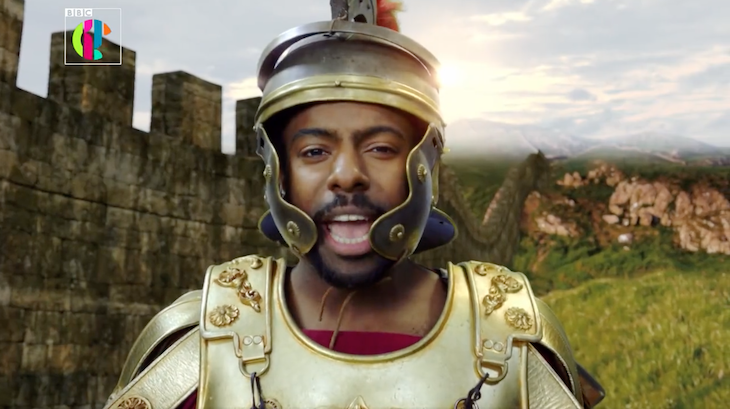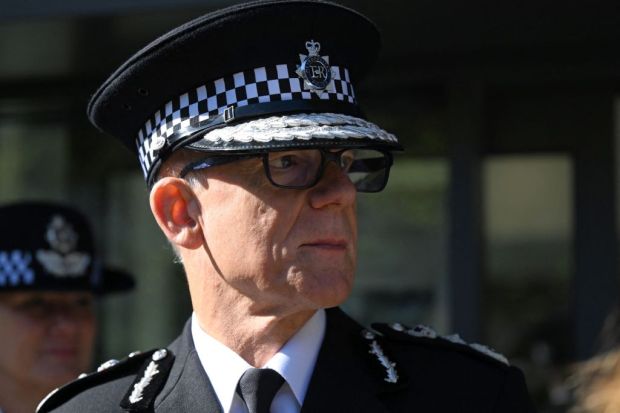I love the BBC’s Horrible Histories; in fact, I’m on record as saying it’s among the best things about being a parent. The show, which in its first five seasons starred the six actors who went on to make Ghosts, has engaged children and adults alike with a dry wit that owes much to Blackadder. Go and have children just so you have an excuse to watch it.
One of its highlights is the music, and the most brilliantly crafted songs, works of genius such as the Scorpions-inspired Viking rock anthem, a song about the Pilgrim Fathers based on ‘Empire State of Mind’, the Kings of Leonesque ‘Alexander’ and the finale to the fifth season, a sort of ‘We Are the World’ tribute. Golden memories of my children’s junior years will always rebound upon hearing them – and thanks to Horrible Histories, countless children across the country can recount the kings and queens of England in a way almost none of my generation are able to do.
Based on the Terry Deary books, the show had the same idea of making history fun by highlighting the bloody and the absurd, the bits your teachers never told you about, a theme emphasised in its closing lyrics ‘Gory, ghastly, mean and cruel/ Stuff they don’t teach you at school!’
The idea that Britain was multicultural in any meaningful sense before even the twentieth century stretches the definition of that word
The ‘stuff they don’t teach you at school’ has also become a common refrain among more grown-up historians in recent years, especially with a particular type of revisionism about Britain’s past. There is nothing wrong with revisionism, of course – it’s the very nature of history – but much of the time the reason you didn’t learn it at school was because it didn’t happen.
This is especially true with the rewriting of British history as multicultural, a trend that began in the late 1990s but has accelerated in the past decade. And so it has come to Horrible Histories, in the form of the song ‘Been Here from the Start’, which came out in 2021 but has only recently made the rounds on social media.
The song, about the history of black people in Britain, features lines such as:
‘We worked in the Stone Age,
Went to war with Bonaparte;
Before these isles were British
Black people played their part.Cheddar Man was Mesolithic
10,000 years from now,
When the animals were terrific
(You should see his giant cow.)And the Roman Emperor General
And the brave Aurelian Moors,
Were just a few of several
Who walked upon these shores.These histories are just stories, there’s truths for us to see
That for 10,000 British years some Brits have looked like me.
And today the future’s hopeful; Rashford and Stormzy light the way
Evaristo, Blackman, Hamilton, Kaluuya and many more names to say.’
The phrase ‘rewriting history’ will always be open to rebuttal because history is always being rewritten, and every history of the past is in a sense a portrait of the era it is written in. But the attempt to cast British history as multicultural is something quantitatively different.
To start at the beginning, Cheddar Man, the oldest intact skeleton in the British Isles, belonged to a group called the Western European Hunter Gatherers, the earliest inhabitants of this island after the Ice Age retreated. Although contested, it is entirely possible that these ancient Britons had dark skin, although the implications of this are not as progressive as you might think.
His people were largely replaced by Mediterranean farmers about 6,000 years ago, who in turn were conquered by the Beaker People (of Stonehenge fame) two millennia later. For both the hunter gatherers and the farmers, judging by the scarcity of their DNA in the subsequent population, these migrations were probably extremely traumatic to the natives.
At some point Celtic-speaking people arrived on the islands, although our understanding of when has recently been upended by new findings; it may have been the first millennium BC, or perhaps much earlier. But certainly they were the main inhabitants by the time Pytheas, a Greek sailor from Marseilles, first discovered this mysterious island in the fourth century BC. He called it Bretannikē, which probably meant ‘land of the painted people’ in the native language.
But then all that changed, with the coming of empire – and diversity.
Housesteads fort on Hadrian’s Wall was manned by Tungarians from today’s Belgium, while Great Chesters was home to Astures from north-west Spain, men from Hama in Syria, Dalmatians, Iraqis and Algerians. Arbeia at South Shields means ‘fort of the Arab troops’, or perhaps more accurately ‘Near Eastern troops’, the men coming from Mesopotamia. An inscription at Burgh by Sands near Carlisle also recalls a cohort from Mauri from modern-day Mauretania.
Until the mid-twentieth century the migrant population of Britain was small
Roman society, while brutal and dependent on slavery, offered extraordinary social and geographic mobility, and we know that Quintus Lollius Urbicus, governor of Britain in the mid-second century, had grown up in Tiddis, in modern-day Algeria, in a Berber family.
Especially moving is the story of Barates of Palmyra, a city largely destroyed by Isis in the twenty-first century, who was stationed on Hadrian’s Wall and married a local British woman, Regina. Judging by the tombstone he had erected for his wife, he must have truly loved her.
Among these migrants were people of black African origin. The Ivory Bangle Lady buried in York came from North Africa and may have had sub-Saharan ancestry. There were certainly records of ‘Ethiopian’ soldiers, a term more loosely applied to black people generally, but one ancient Roman who wasn’t black was the Emperor Septimius Severus, often wheeled out during Black History Month because he came from modern-day Libya, of mixed north African and Italian ancestry.
In fact, far from being a BHM pin-up, on one occasion the emperor was offered a garland by an ‘Ethiopian’ soldier and was so startled that he regarded it as a bad omen. Yet that there were black soldiers in Britain, as well as North African and Near Eastern troops, is neither contested nor surprising. Empires are multicultural by nature.
Roman Britain, compared to what came before and after, was diverse, but the scale of this diversity is of clear political interest in the 21st century, and so subject to exaggerations. As an example, the ‘anti-racist charity’ which recently looked into the city of York made the claim that: ‘It has been suggested by one historian that at around that time, the population of York, largely a military garrison town, was predominantly Black.’ This seems unlikely, to put it mildly.
In a response to the BBC song, historian and YouTuber Tom Rowsell points out that genetic studies of pre- and post-Roman Britain suggest that imperial occupation left little or no genetic contribution, something shown by at least two different studies. Rowsell makes the comparison with India, which the British ruled for two centuries without leaving any genetic trace. (Perhaps, just as many Anglo-Indians left with retreating British forces, Romano-Britons of mixed heritage were most able and likely to flee when the province began to collapse into warlordism and invasion.)
In contrast, today’s (white) English population derive the majority of their ancestry from pre-Roman Britons, the English being essentially a cross between a German and a Welshman. The modern English population has a direct link with both the pre-Roman people living on this island, and with the Anglo-Saxons who followed; this is not true for modern-day migrant communities.
Although schools across the country now teach otherwise, the idea that Britain was multicultural in any meaningful sense before even the twentieth century stretches the definition of that word to a point where only sophists will tread.
A 2015 report from the ‘Study of People of the British Isles’ project ‘found that the British population was very homogeneous by conventional measures’, in the words of David Reich, with a high degree of relatedness suggesting historically low levels of migration, at least since the Conquest.
The term ‘nation of immigrants’, originally applied to the United States, first began to be used in Britain in the Blair era. In a September 2000 speech to the Institute for Public Policy Research, Immigration Minister Barbara Roche said: ‘This country is a country of migrants and we should celebrate the multi-cultural, multi-racial nature of our society, and the very positive benefits that migration throughout the centuries has brought.’
In 2004, writing in Progress magazine, Roche said we must ‘embrace our past as a nation of immigrants. History should not be all about kings and queens, dates and battles, but should look at how immigration is firmly entwined with any notion of what it is to be British.’
That is how it came to be – despite not really being true at all.
Until the mid-twentieth century the migrant population of Britain was small, and its non-European population miniscule. There have certainly been African populations since the sixteenth century, and even evidence of isolated African individuals in the medieval era.
Around 10,000 Africans, mostly men, came to Britain during the era of Transatlantic slavery, but they left little in the way of descendants and a survey of Y chromosomes of 1,772 British men failed to find any of similar type to that most frequently found among African men.
Britain’s African community in the eighteenth century is estimated to have comprised 0.2 per cent of the population, mostly concentrated in ports; after that it went into decline, perhaps a result of the 1772 ruling on slavery in England.
Similarly, until the mid-twentieth century the Asian population was ‘minute’, according to David Conway, author of ‘A Nation of Immigrants?’ There were perhaps 7,000 Indians in Britain before the second world war, of whom 1,000 were doctors.
There were, of course, a number of significant figures of African or Asian descent long before the arrival of the Windrush. Britain had several MPs of black or partial black heritage, the oldest possible contender being James Townsend. Anglo-Indian David Ochterlony Dyce Sombre was elected to Parliament in 1841, while there have been black footballers since the very start of the Football League.
But before the war the non-white population of Britain was estimated to be in the low ten thousands, less than 0.1 per cent of the population. This is certainly not the impression one would get from watching any BBC historical drama of the past five years.
As Christopher Caldwell once put it: ‘Pocahontas, the Fuegian Indians brought to Britain on the HMS Beagle, Alexander Pushkin’s black grandfather, or three Chinese families running a laundry in a Roman backstreet do not a “country of immigrants” make.’ The question is: why have we chosen to deliberately teach otherwise?
This article first appeared on Ed West’s Wrong Side of History.<//>
Got something to add? Join the discussion and comment below.
Get 10 issues for just $10
Subscribe to The Spectator Australia today for the next 10 magazine issues, plus full online access, for just $10.



















Comments
Don't miss out
Join the conversation with other Spectator Australia readers. Subscribe to leave a comment.
SUBSCRIBEAlready a subscriber? Log in